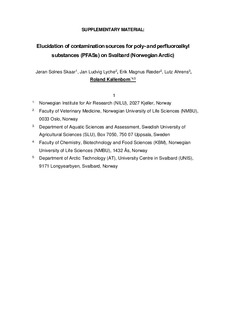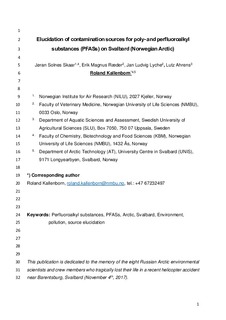| dc.description.abstract | A combination of local (i.e. firefighting training facilities) and remote sources (i.e., long-range transport) are assumed to be responsible for the occurrence of per- and polyfluoroalkyl substances (PFASs) in Svalbard (Norwegian Arctic). However, no systematic elucidation of local PFASs sources have been conducted yet. Therefore, a survey was performed aiming at identifying local PFASs pollution sources on the island of Spitsbergen (Svalbard, Norway). Soil, fresh water (lake, draining rivers), sea water, melt-water run-off, surface snow and coastal sediment samples were collected from Longyearbyen (Norwegian mining town), Ny-Ålesund (research facility) and the Lake Linnévatnet area (background site) during several campaigns (2014-2016) and analysed for 14 individual target PFASs. For background site (Linnévatnet area, sampling during April to June 2015), ∑PFAS levels ranged from 0.4 – 4 ng/L in surface lake water (n = 20). PFAS in melt water from the contributing glaciers showed similar concentrations (~4 ng/L, n = 2). The short chain perfluorobutanoate (PFBA) was predominant in lake water (60-80% of the ∑PFASs), meltwater (20-30 %) and run-off water (40 %). Long range transport is assumed to be the major PFAS source. In Longyearbyen, 5 water samples (i.e. 2 seawater, 3 run-off) were collected near the local firefighting training site (FFTS) in November 2014 and June 2015, respectively. The highest PFAS levels were found in FFTS melt water run-off (118 ng/L). PFOS was the most abundant compound in the FFTS meltwater run-off (53 – 58 % PFASs). At the research station Ny-Ålesund, sea water (n = 6), soil (n = 9) and fresh water (n = 10) were collected in June 2016. Low ∑PFAS concentrations were determined for sea water (5 - 6 ng/L), whereas high ∑PFAS concentrations were found in run-off water (113 – 119 ng/L) and soil (211 – 800 ng/g dry weight (dw)) collected close to the local FFTS. In addition, high ∑PFAS levels (127 ng/L) were also found in fresh water from lake Solvatnet close to former sewage treatment facility. Overall, at both FFTS affected sites (soil, water), PFOS was the most abundant compound (60 – 69% of ∑PFASs). FFTS and landfill locations were identified as major PFASs sources for Svalbard settlements. | nb_NO |

